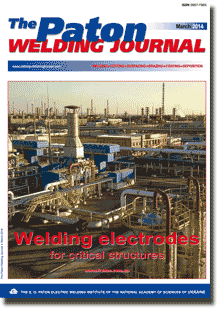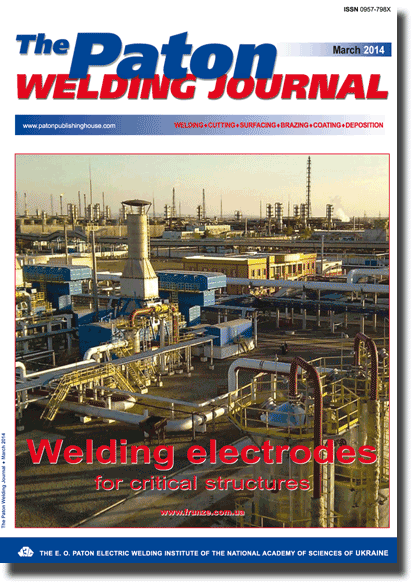| 2014 №03 (05) |
DOI of Article 10.15407/tpwj2014.03.06 |
2014 №03 (07) |

The Paton Welding Journal, 2014, #3, 33-38 pages
PROSPECTS FOR DEVELOPMENT OF LOAD-CARRYING ELEMENTS OF FREIGHT CAR BOGIE
O.V. MAKHNENKO, G.Yu. SAPRYKINA, I.V. MIRZOV and A.D. PUSTOVOJ
E.O. Paton Electric Welding Institute, NASU. 11 Bozhenko Str., 03680, Kiev, Ukraine. E-mail: office@paton.kiev.ua
Abstract
In recent years accidents related to fracture of cast load-carrying elements of three-piece bogies of freight cars have become more frequent in the railways of Ukraine and Russia. The work substantiates the rationality of development and application of all-welded load-carrying elements of freight car bogie (FCB), improving their operational reliability. Welded structures of FCBs are widely applied in West Europe. Attempts to develop structures of all-welded elements of FCBs irreplaceable with cast structures are made in Ukraine and Russia. However, none of the developed welded structures is currently applied at regular cargo transportation, because of non-optimal design of bogie welded elements in terms of ensuring the required fatigue resistance margin. To develop a competitive welded solebar and bogie bolster it is, first of, all necessary to increase the fatigue resistance of bogie elements, improve the accuracy of solebar fabrication to avoid skewing of wheelset axles, leading to fast wear, lower their weight and cost, increase element run between scheduled depot repairs. Strength analysis of bogie welded elements should be performed in keeping with the norms currently in force, as well as current world standards, norms and recommendations, allowing for the most recent achievements in the field of dynamics of railway cars and methods to determine welded joint fatigue resistance. 20 Ref., 8 Figures.
Keywords: welded structure, three-piece bogie of freight car, solebar, bogie bolster, solebar fracture, fatigue resistance
Received: 30.07.13
Published: 28.03.14
References
1. Sokolov, A.M. (2012) About formation of complex program of R&D on problem of fractures of solebars of freight car bogies. Byul. Obied. Uch. Soveta OAO «RZhD», 3, 3-11.
2. Pranov, V.A. (2012) Increase in fatigue life of freight car bogies: Syn. of Thesis for Cand. of Techn. Sci. Degree. Ekaterinburg.
3. Oganian, E.S. (2013) Conditions of safety service of cast parts of freight car bogies. Byul. Obied. Uch. Soveta OAO «RZhD», 3, 13-19.
4. Danilenko, S.S. (2004) Investigation of stress-strain state of solebar of bogie 18-100 taking into account the technological dispersion of geometrical parameters of its section: Syn. of Thesis for Cand. of Techn. Sci. Degree. Bryansk STU.
5. Monastyrsky, A., Bubnov, V., Kotenko, S. et al. (2012) Fracture of solebar of freight car bogie. Analysis of production technology, ways of defect elimination. CADmaster, 5, 60-65.
6. Volkov, V.A., Chepurnoj, A.D., Bubnov, V.M. et al. Two-axle bogie for freight car. Pat. 2275308 Russia. Int. Cl. B61F5/38; B61F5/26; B61F5/12; B61F3/02. Publ. 27.04.2004.
7. Makhnenko, V.I., Garf, E.F., Rimsky, S.T. et al. (2006) Welded freight bogie bolster project. The Paton Welding J., 4, 2-8.
8. Dejneko, S.Yu., Prikhodko, V.I., Bondar, N.A. et al. Two-axle bogie of freight car. Pat. 2246416C2, Russia. Int. Cl. B61F5. Publ. 20.06.2004.
9. http://www.nvc-vagon.ru
10. Sharapov, A.A., Goloviznin, B.L., Malykh, N.A. et al. Bogie of railway car, solebar and bolster of railway car. Pat. 2373091C2 Russia. Int. Cl. B61F5. Publ. 20.11.2009.
11. (1996) Standards for calculation and designing of railway car of Railroad Ministry of 1520 mm track (non self-propelled). Moscow: GosNIIV-VNIIZhT.
12. Boronenko, Yu.P., Orlova, A.M., Rudakova, E.A. (2005) Designing of running parts of car: Manual. Pt 2: Designing of two-axle freight bogies. St.-Petersburg UPS.
13. (2010) Bolsters and solebar of cast two-axle bogies of freights for 1520 mm track, method of fatigue tests. Moscow: VNIIZhT-NII vagonostroeniya.
14. (2010) Bolsters and solebar of cast two-axle freight bogies for 1520 mm track, method of static strength tests. Moscow: VNIIZhTNII vagonostroeniya.
15. (2006) Recommendations for fatigue design of welded joints and components. IIW Doc. XIII-1965r14-03/XV-1127r14-03.
16. DBN V.2.6-163:2010: Structures of buildings and constructions. Steel structures. Standards of designing, fabrication and assembly. 2nd ed. Kyiv: Minregionbud Ukrainy.
17. Zivkovic, M.V. (2011) Numerical analysis of welded joints of wagon constructions. Zavarivanje i Zavarene Konstrukcie, 3, 101-106.
18. (2006) TSI Standard: Commission Decision of 28 July 2006 concerning the technical specification of interoperability relating to the subsystem rolling stock - freight wagons of the trans-European conventional rail system (notified under document number C(2006)3345).
19. Pr EN 12663.2:2007: Railway applications - structural requirements of railway vehicle bodies.
20. Eurocode 3: Design of steel structures. Pt. 1.9: Fatigue. Appr. 16.04.2004.
Suggested Citation
O.V. MAKHNENKO, G.Yu. SAPRYKINA, I.V. MIRZOV and A.D. PUSTOVOJ (2014) PROSPECTS FOR DEVELOPMENT OF LOAD-CARRYING ELEMENTS OF FREIGHT CAR BOGIE. The Paton Welding J., 03, 33-38.The cost of subscription/purchase order journals or individual articles
| Journal/Currency | Annual Set | 1 issue printed |
1 issue |
one article |
| TPWJ/USD | 384 $ | 32 $ | 26 $ | 13 $ |
| TPWJ/EUR | 348 € | 29 € | 24 € | 12 € |
| TPWJ/UAH | 7200 UAH | 600 UAH | 600 UAH | 280 UAH |
| AS/UAH | 1800 UAH | 300 UAH | 300 UAH | 150 UAH |
| AS/USD | 192 $ | 32 $ | 26 $ | 13 $ |
| AS/EUR | 180 € | 30 € | 25 € | 12 € |
| SEM/UAH | 1200 UAH | 300 UAH | 300 UAH | 150 UAH |
| SEM/USD | 128 $ | 32 $ | 26 $ | 13 $ |
| SEM/EUR | 120 € | 30 € | 25 € | 12 € |
| TDNK/UAH | 1200 UAH | 300 UAH | 300 UAH | 150 UAH |
| TDNK/USD | 128 $ | 32 $ | 26 $ | 13 $ |
| TDNK/EUR | 120 € | 30 € | 25 € | 15 € |
AS = «Automatic Welding» - 6 issues per year;
TPWJ = «PATON WELDING JOURNAL» - 12 issues per year;
SEM = «Electrometallurgy Today» - 4 issues per year;
TDNK = «Technical Diagnostics and Non-Destructive Testing» - 4 issues per year.


